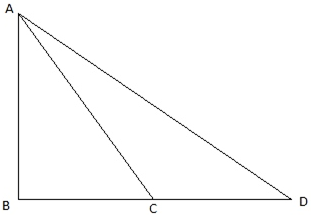If the angles of elevation of the top of a tower from two points at distances a and b from the base and in the same straight line with it are complementary then the height of the tower is

In the above figure, let AB be the tower and C and D be the two points on the ground from where A is observed. Join B, C, D. Let BC = a and BD = b. Join C, D with A. We get two right-angled triangles ABC and ABD with right angle at B. Also, the angles of elevation of the top of the tower AB from C and D are ∠ACB and ∠ADB respectively. These angles are complementary. So, ![]() We are to find the height of the tower, that is, AB.
We are to find the height of the tower, that is, AB.
From ∆ABD,
![]()
Again, from ∆ABC,
![]()
or,
![]()
or,
![]()
Now, multiplying we get,
![]()
or,
![]()
or,
AB = √ab
So the correct choice is (B).
20